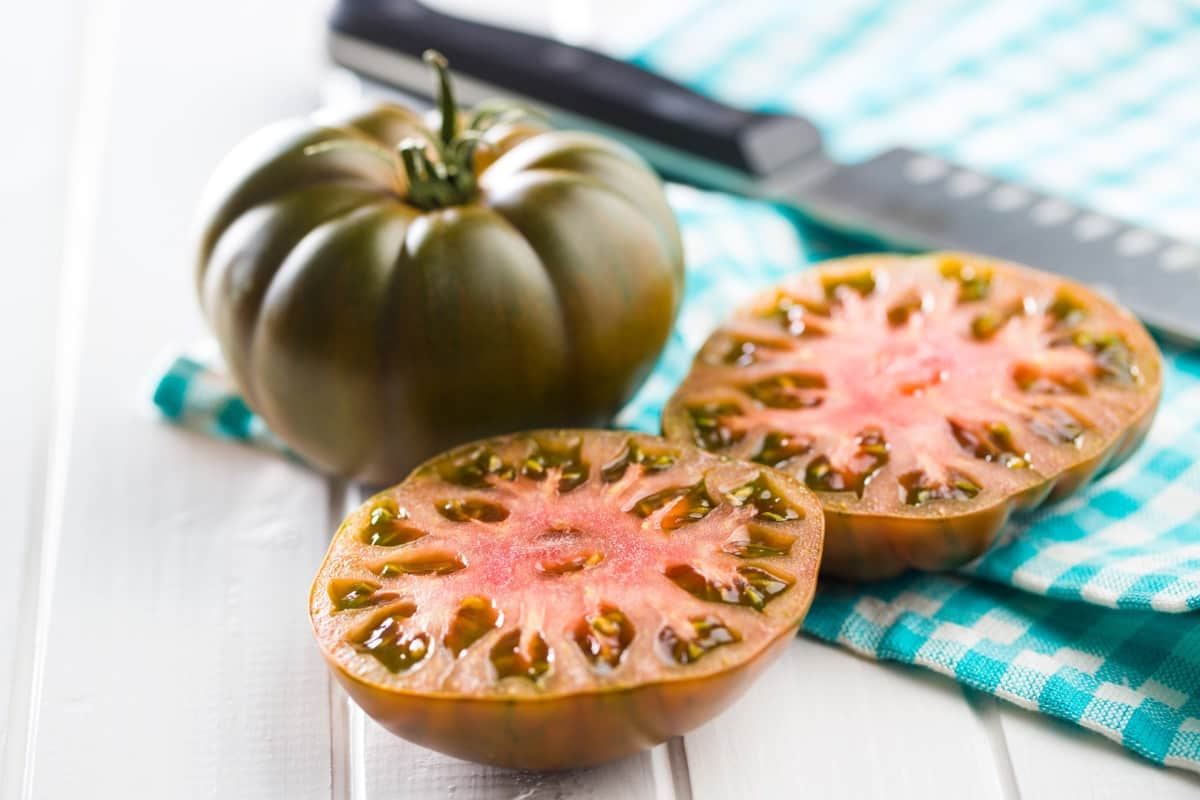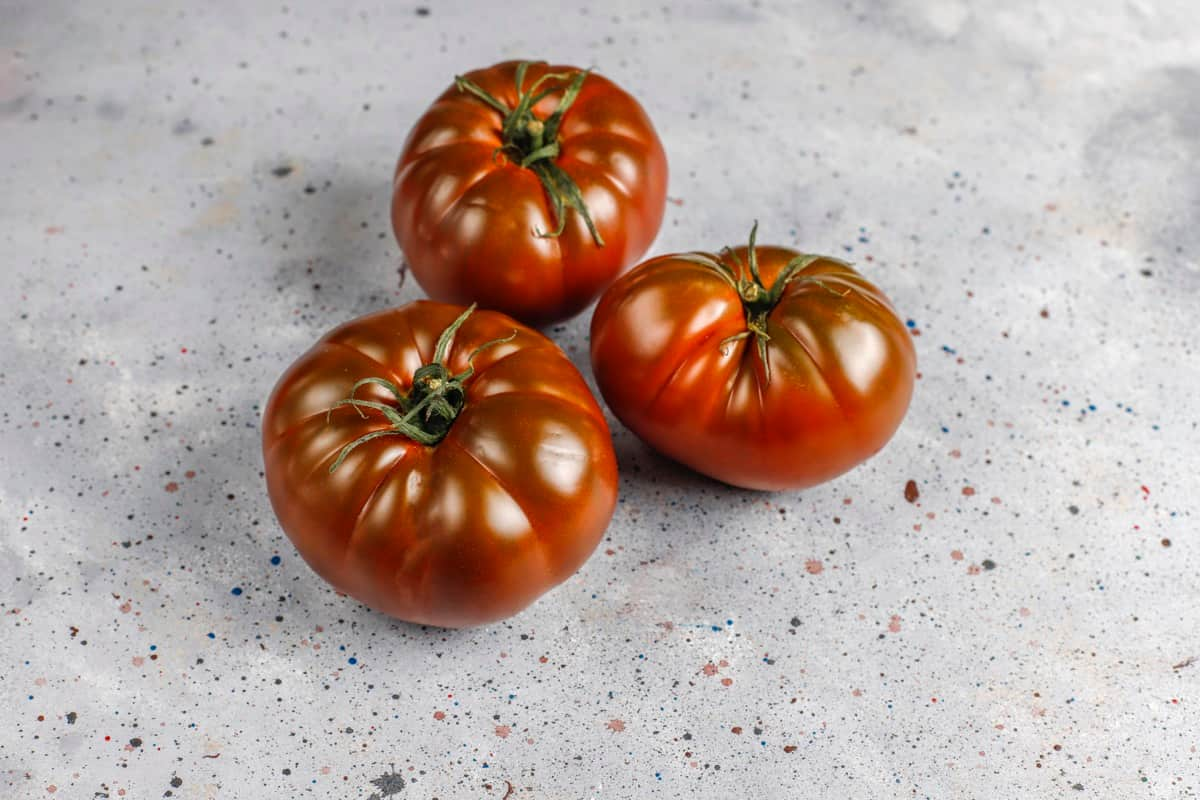Growing and caring for Brandywine Tomatoes can be a rewarding experience for any gardener. Remember to choose a sunny location with well-drained soil, and give your plants plenty of space to grow. Provide support such as stakes or cages to keep the vines upright and water consistently but avoid overwatering. Following planting instructions and providing proper care, you can have a bountiful harvest of these delicious and flavorful tomatoes.

How to Grow and Care for Brandywine Tomatoes
How to Grow Brandywine Tomatoes From Seeds
First, choose high-quality Brandywine Tomato seeds and sow the Brandywine Tomato seeds indoors about 6-8 weeks before your last frost date. Fill small seed trays or pots with seed-starting mix and plant one seed per container at a depth of ¼ inch. Place the containers in a warm location and keep the soil moist but not soggy. After germination, provide ample light using fluorescent grow lights or place the seedlings near a sunny window.
Once your Brandywine Tomato seedlings have developed their first true leaves, it’s time to transplant them into larger individual pots. Choose containers at least 4 inches deep to accommodate their growing root systems. Gradually acclimate your young plants to outdoor conditions by placing them outside for short periods, increasing exposure over several days. This will help prevent shock when transplanting into garden beds or larger containers.
When planting your Brandywine Tomato transplants outdoors, select a sunny spot with well-draining soil enriched with organic matter. Dig holes deep enough so that only the top set of leaves is above ground level; burying some of the stems encourages stronger root development. Mulching around plants can retain moisture and suppress weeds while regulating soil temperature.
Brandywine Tomato Planting Instructions
Brandywine Tomatoes are known for their delicious flavor and juicy texture. To enjoy a bountiful harvest of these tasty tomatoes, it’s important to start with proper planting instructions. First, choose a place in your garden or find a large container to grow them in pots. Brandywine Tomatoes need at least 6-8 hours of direct sunlight daily to thrive.
Brandywine Tomatoes prefer well-draining soil, so adding organic matter like compost can help improve the soil structure and fertility.
When planting your seedlings or transplants, dig deeper than the root ball and gently place the plant into the hole. Fill around the roots with soil, firming it gently but not too tightly. To give your plants extra support as they grow taller, use stakes or cages to prevent them from sprawling on the ground. This will also help keep their foliage off damp soil, reducing disease risks.
Aim for deep watering once or twice a week rather than frequent shallow watering, which can lead to shallow root development. Organic mulches like straw or wood chips work best for Brandywine Tomatoes. Regarding spacing, allow 3 feet between each plant when growing multiple Brandywines in rows. If using containers, ensure each pot has enough space for adequate root growth.
Caring for Brandywine Tomato Plants
Once you have successfully planted your Brandywine Tomato seedlings, providing them with the proper care they need to thrive is crucial. Brandywine Tomatoes require consistent and even watering throughout their growing season. However, be cautious not to overwater as it can lead to root rot. It’s best to water deeply once or twice a week rather than shallowly every day. Applying organic mulch around your plants helps retain moisture in the soil while preventing weeds.
As Brandywine Tomato plants grow, they tend to become heavy due to their large fruit size. Use stakes or cages for support to prevent the branches from breaking under this weight. While pruning isn’t necessary for all tomato varieties, removing the suckers (the small shoots sprout between main stems and leaf axils) can help redirect energy into producing larger fruits. Brandywine Tomatoes benefit from regular feeding with a balanced organic fertilizer high in phosphorus and potassium but low in nitrogen.
Best Soil for Brandywine Tomatoes
When it comes to growing Brandywine Tomatoes, the soil you choose plays a key role in their success. These heirloom tomatoes thrive in well-drained, nutrient-rich, slightly acidic soil. Prepare the planting area to create the best soil for your Brandywine Tomatoes. Remove any weeds or debris and loosen the soil to a depth of 12 inches. This will help promote healthy root growth.
Next, amend the soil with organic matter such as compost or aged manure. This will improve its fertility and drainage capabilities. Mix about 2-3 inches of organic matter into the top layer of soil. Brandywine Tomatoes also benefit from added calcium in the soil. You can achieve this by adding crushed eggshells or agricultural lime to increase calcium levels and prevent blossom end rot.
In case you missed it: How to Treat Powdery Mildew in Tomato Plants: A Comprehensive Identification and Control Guide

Watering Schedule for Brandywine Tomatoes
When watering your Brandywine Tomato plants, striking a balance is important. You don’t want to drown them in excessive water, nor do you want to let them dry out completely. Aim for a regular watering routine that keeps the soil moist but not soggy. If heavy rainfall or the soil feels moist an inch below the surface, hold off on watering until it becomes drier.
To avoid leaf diseases and fungal issues, water at the base of the plant instead of overhead. This helps keep foliage dry and reduces the risk of infections. Monitor your plants regularly and adjust your watering schedule as needed.
Fertilizing Brandywine Tomato Plants
When it comes to growing Brandywine Tomatoes, proper fertilization is key. Before planting your seedlings or transplants, mix some organic compost into the soil. This will enrich the soil with beneficial microorganisms and nutrients that nourish your plants throughout their growing season. Once your tomatoes are established, it’s time to begin fertilizing. Apply a slow-release granular fertilizer around each plant according to package instructions.
Pruning Techniques for Brandywine Tomatoes
Pruning your Brandywine Tomato plants ensures their healthy growth and maximizes fruit production. First, start by removing any suckers that develop between the main stem and the branches. These suckers take away energy from the main plant and can lead to crowded foliage, reducing air circulation and increasing the risk of diseases. Use sharp pruners or garden scissors to snip off these small shoots.
Next, removing any lower leaves that come into contact with the ground is important. This helps prevent soil-borne diseases from splashing onto the leaves when it rains or during watering. It also improves air circulation around the plant, preventing fungal infections. As your Brandywine Tomato plants grow taller, you may need to provide support such as stakes or cages to keep them upright. Be sure to tie up any sprawling branches using soft plant ties or twine, gently securing them without causing damage.
Protecting Brandywine Tomatoes From Pests and Diseases
To ensure a healthy crop of these juicy tomatoes, it’s important to take preventive measures. Keep a close eye on your plants for signs of pests such as aphids or tomato hornworms. These pesky critters can quickly decimate your tomato plants if left unchecked. If you spot any pests, several organic options exist for controlling them. Neem oil is a popular choice as it acts as an insecticide and fungicide. Dilute it with water according to the instructions on the bottle and spray it onto your plants.
Another natural remedy is introducing beneficial insects like ladybugs or praying mantises into your garden. These predator insects will help control pest populations by feeding on them. In addition to pests, Brandywine Tomatoes are also prone to diseases such as blight and powdery mildew. To prevent these issues, avoid watering from above, which can create humid conditions ideal for disease development.
Harvesting Brandywine Tomatoes at the Right Time
Harvesting Brandywine Tomatoes immediately ensures you enjoy their sweet, flavorful taste. When determining the right time to harvest your Brandywine Tomatoes, look for signs of ripeness. The fruits should have turned from green to a beautiful shade of deep pink or red. Gently squeeze the tomato – if it feels firm and gives slightly under pressure, it’s ready for picking.
In case you missed it: 15 Plants to Avoid Planting With Tomatoes

To harvest your Brandywine Tomatoes, twist them gently off the vine. Avoid pulling or yanking on the fruit, as this can damage the tomato and its stem. It’s important not to pick your Brandywine Tomatoes too early in their development, as they won’t reach their full flavor potential. However, be mindful not to leave them on the vine for too long, as overripe tomatoes may become mushy and less tasty.
Conclusion
Growing and caring for Brandywine Tomatoes can be a rewarding experience for any gardener. Starting with planting, choosing a sunny location with well-drained soil is crucial. Remember to space out your plants adequately and provide support as they grow taller. Caring for your tomato plants involves regular watering, mulching, and fertilizing to ensure healthy growth.
Keep an eye out for pests and diseases affecting your plants, taking necessary precautions. When it comes time to harvest your Brandywine Tomatoes, wait until they are fully ripe on the vine before picking them. This will guarantee the best flavor and quality of each fruit.
- Feed Your Flock for Less: Top 10 Tips to Save on Chicken Feed
- Ultimate Guide to Ossabaw Island Hog: Breeding, Raising, Diet, and Care
- Hatching Answers: The Top 10 Reasons Your Chickens Aren’t Laying Eggs
- Eggs and Economics: Breaking Down the Cost of Raising Backyard Chickens
- Defend Your Greens: Proven Methods to Keep Iguanas Out of Your Garden
- Ultimate Guide to Cinnamon Queen Chicken: A Comprehensive Guide for Beginners
- Ultimate Guide to California Tan Chicken: Breeding, Raising, Diet, Egg-Production and Care
- Ultimate Guide to Marsh Daisy Chicken: Breeding, Raising, Diet, and Care
- 10 Types of Chicken Farming Businesses You Can Start for Profits